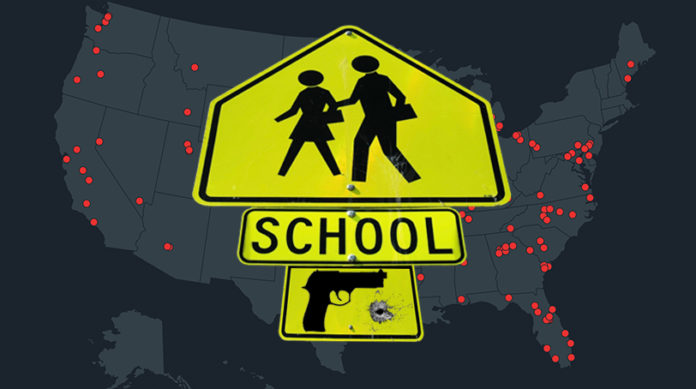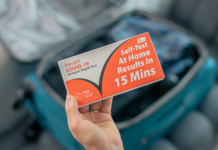It was just when I was starting to write about the rise in recent school shootings that I got to know about the Santa Fe High School shooting. Across America, the number of grieving parents is growing month by month. Even hour by hour. My heart breaks for all the students and parents who have had to go through such a hard time just because someone so heartless decided to open fire. I wonder what goes inside in minds of these mass shooters?
Gun-related violence in schools is a pervasive issue and has greatly increased in recent years. In all of 2017, there were 44 shootings in elementary and secondary schools, resulting in 25 deaths and 60 injuries.
So far in 2018, there have been 28 elementary and secondary school shootings, resulting in 40 deaths and 66 injuries. With the year not even halfway over, 2018 already has more injuries and deaths than all of 2017 and appears to be on track to outpace 2017 in terms of overall incidents. During the 1950’s, there were 17 school shootings; in the 1960’s, 18; in the 1970’s, 30; in the 1980’s, 39; in the 1990’s, 62; in the first decade of this century (2000-2009), 60 school shootings; from 2010-2018, 153. . . . As these statistics reveal, school violence has increased by 19% in the 21st century. Stakeholders, including parents, teachers, counselors, administrators, and students alike are gravely concerned about safety in their schools. From Columbine to Sandy Hook, with most recently Marjory Stoneman Douglas High School, Parkland, Florida, and Santa Fe High School, Santa Fe, Texas, innocent lives are being claimed by senseless acts of gun violence.

An assault weapons ban, universal background checks, single-point-of-entry schools, metal detectors, an armed law enforcement officer in every school… all of these are aimed at stopping school shootings after the shooter has already committed this inhuman act.
We hear a lot about the causes and the possible preventions right after a school shooting. We know that there are debates about mental health and gun control. Politicians on both sides send their thoughts and prayers to the families of the killed and then go to their respective sides of the aisle in Washington.
What Triggers School Shootings?
Gun control advocates would argue that it’s easier to get a gun today and we need stricter gun control measures. But that’s not technically correct. The Gun Control Act wasn’t even passed until 1968. Since then, gun control legislation has become stricter, while mass shootings have escalated. Logically speaking, merely seeing or even holding a gun doesn’t somehow incite most people to commit a mass murder. This would seem to imply that there is a deeper, non-legislative issue driving gun violence.
Bullying & Rejection
Bullying has been tied to a number of school shootings in the United States, although this has been difficult to corroborate. According to a research conducted by the LA Times, at least 59% of the 185 public mass shootings that took place in the United States from 1900 through 2017 were carried out by people who had either been diagnosed with a mental disorder or demonstrated signs of serious mental illness prior to the attack.
School shooters don’t commit mass shootings to bully people; they commit them because they feel victimized and want to seek revenge or right a wrong.
Mental Health
The country for sure needs stricter gun control laws, but when are we going to face the hard truth about the mental health stigma? Parkland, Florida shooting suspect Nikolas Cruz, refused to let the school district continue providing him with mental health services after he turned 18, and the superintendent of schools said federal law kept officials from doing anything about it. Broward Schools Superintendent Robert Runcie told the Sun Sentinel, “You can’t make someone do something when the law says they have the right to make that determination.”
Parkland school administrators knew of Cruz’s behavioral issues so well they expelled him. Local police knew about him from frequent calls. Social workers knew of his troubled life. Mental health counselors too. School friends joked he was a shooter. Yet he could still pull it off. And police responded by waiting outside the school.
Studies have shown that 1 in 5 high school students show symptoms of a mental health disorder, while only 6-9% utilize mental health services. 80% of mentally ill students may not be receiving the help that they need.
Key findings regarding school shooters included the following:
- A majority of perpetrators acquired guns used from their own or a relative’s home.
- Perpetrators had easy access to family-owned firearms.
- Perpetrators often “leaked” their intent to peers.
- Perpetrators often engaged in behavior prior to the incident that caused others concern (e.g., weapon seeking, disturbing writings).
- Perpetrators had often considered or attempted suicide.
What Can Be Done?
- Resources should be increased to provide enhanced education, beginning in elementary school, with a focus on constructive coping skills for anger and conflict resolution, mental health, and mental wellness education.
- Being Alert – Students should be able to alert authorities about suspicious behavior and violent students.
- Greater Counseling – Unfortunately, there are simply not enough guidance counselors, social workers, or school psychologists in schools to monitor the hundreds of students they are responsible for; one single school psychologist is responsible, on average, for 1400 students.
- Controlled Social Media Influence – Florida shooter, Nikolas Cruz left a number of clues before committing the deadly crime. The real reason the FBI and local law enforcement didn’t connect the dots is because they don’t fully understand the new dots of social media.
- Instagram pictures of mutilated frogs, weapons and knives.
- “I whana (sic) shoot people with my AR-15”
- “Im (sic) going to be a professional school shooter.” Signed with his real name.
- “I could have done better,” referencing a mass shooting in New York
Compared to other countries, the United States appears to have more lethal violence and that’s driven in large part by the prevalence of guns. People of every country get into arguments and fights with friends, family, and peers. But in the US, it’s much more likely that someone will get angry at an argument and be able to pull out a gun and kill someone.
In The End
Children who just want to attend their school and learn so they can have a better life, go to school one day where their life is over in a flash. No matter how we get about the whole situation, we merely go on about our daily lives and wait for the next story to come along. School shootings may never end in our country until we take a deep look within ourselves, understand whether we make positive or negative contributions in life, and then start to really look at those around us and understand if they are suffering in silence and need our help.
Tanya Sawhney is a local Freelance Journalist and can be reached at: mailtanya05@gmail.com




